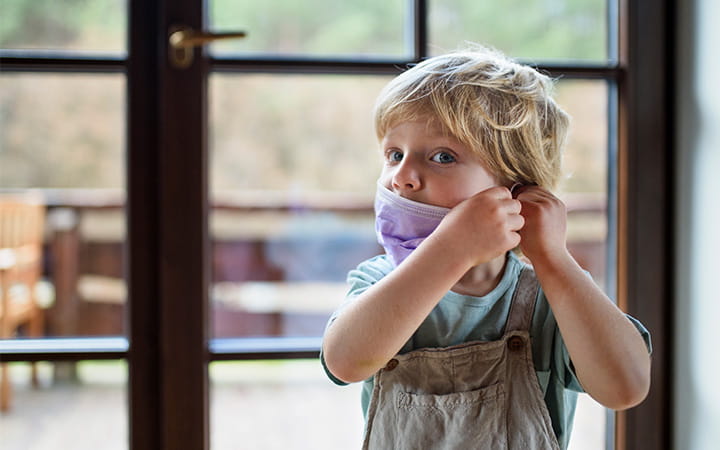How to Help Your Child Get Used to Wearing a Mask
June 10, 2020
 University Hospitals Rainbow Babies & Children'sExperts in Children's Health
University Hospitals Rainbow Babies & Children'sExperts in Children's Health

One part of adjusting to life during the COVID-19 pandemic has been the wearing face masks or facial coverings. Many stores, offices, places of employment or indoor public places request or require a face mask or covering to enter.
Cloth face coverings help reduce the chance of spreading viruses through respiratory droplets or the spray of saliva. This is especially important if you are within six feet of another person, which is the typical range in which coughs or sneezes can transmit infections.
If you or your family are in a location where social distancing of at least six feet apart is not an option, a face covering is recommended to help prevent spread of the coronavirus.
It is important that children wear masks when they are going to their doctor’s appointments, to a store and when they are around people other than family members who live in their home. Explain to your children that even when they are wearing masks, they should still stand six feet away from others.
Unsettling for Children
Children thrive on routines, and this change in how they see people in their community can be unsettling.
Kids rely on facial features to recognize other children and adults. Facial cues also help children feel comfortable. Covering faces helps slow the spread of viruses, but it also blocks the view of the friendly smiles and encouraging facial expressions that typically set kids at ease. Covering the faces of even familiar adults, like parents and caregivers, can be scary. Asking kids to cover their own face can be equally anxiety provoking.
It’s important to know that it’s normal for kids to feel uneasy or anxious with these changes. Try these tips to help kids get more comfortable:
- Talk about this subject now to give kids a heads up about what to expect when they venture out of the house. Explain that masks are worn to keep everyone safe.
- Focus on the positive aspects of a mask rather than the negatives of the virus. Let kids know that masks help keep us and other people in our community safe!
- Let your kids know that you may all have to wear a mask at times. Put one on yourself at home so they can see that it is not scary. Try putting the mask on a doll or stuffed animal to get kids more comfortable with this.
- Give kids plenty of time and space to get used to this new idea of masks. Leave out some masks for imaginary play or making drawings, including people or animals with masks on.
- Show your children that masks are made of cloth, the same fabric as their clothes.
- Older children may fear that if they wear a mask they will look different than their peers, or people will think they are sick. Let your kids see that lots of people of wearing masks right now. Look up pictures of kid wearing masks. Ensure your child that they will blend in wearing a mask rather than feeling singled out.
- Get your kids involved with their masks! Try making your own masks at home. Let kids help. There are many no-sew patterns and ideas out there using common items like bandanas and hair ties. If using a surgical mask, let kids decorate the mask with stickers or patterned tape.
- Teach kids how to take the mask on and off to get used to how to do this, and how it feels on their face.
- However your child reacts, accept this as a normal reaction to a rather scary change. Allow them to feel whatever they are feeling and offer comfort.
- Remind your kids that some things remain constant no matter what changes are to come, like how you are always there for them.
Nellie Coughlin, MSN, APRN, PPCNP-BC, is a certified pediatric nurse practitioner at UH Rainbow Babies & Children’s Hospital.
RELATED LINKS
Learn more about the symptoms of COVID-19, the illness caused by the coronavirus, and what you should do if you think you have the virus.


